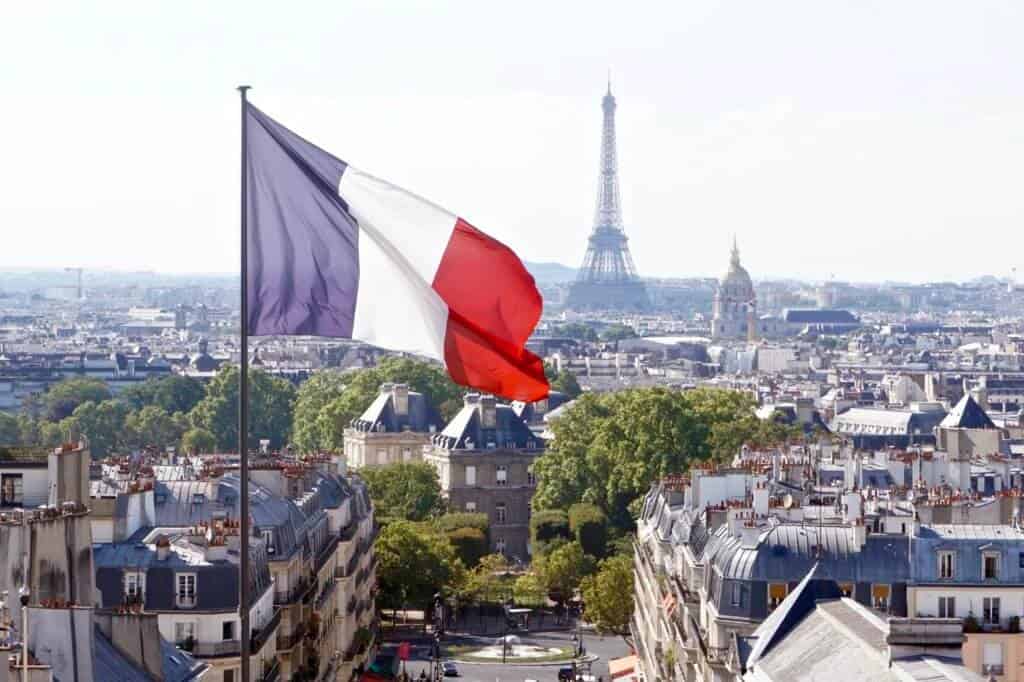The Long & Surprising History and Origins of the French Flag
Last Updated on 26th June 2024 by Sophie Nadeau
This post may contain affiliate links. Please check out my privacy policy and disclosure for more information.
Also known as the French Tricolore, the French Flag has a long history, which I’ll be discussing today. If you’ve ever been to Europe, then no doubt you’ll soon recognise one of the most iconic emblems of France.
Characterised by its red, white, and blue appearance, the three colour flag of l’Hexagone, i.e. the National Flag of France is synonymous with France. And for those who are curious… it’s worth knowing that ‘flag’ is known as ‘drapeau’ in French…

Contents
What does the flag of France look like?
The French flag should be horizontally orientated when displayed, and should be made at a ratio of 2:3 when it comes to proportions. Rather curiously, though the red, white, and blue parts of the flag are all within proportion to one another.
When the flag was first created, it was stipulated that the flag be at a ratio of 30 parts (blue), 33 parts (white) and 37 parts (red). Luckily for us, this stipulation was soon dropped and so it’s much easier to reproduce the flag today!
However, as you may well have discovered for yourself when taking in pub quizzes and trivia rounds, many flags of the world can look similar to one another. For example, the stripes of the French flag are displayed in a vertical fashion of blue, followed by white, and then red.
As such, the French flag should not be confused with similar looking flags such as that of Luxembourg (which has a slightly lighter blue) and that of the Netherlands. These flags are also blue, white, and then red, though the stripes are displayed horizontally as opposed to vertically.

A History of the French Flag
Prior to the French Tricolore, French kings would have used varying versions of golden flowers (known in French as the fleur de lys) on a blue background during the 12th-century. The flag would have been displayed as a banner by Louis VII when he was leaving for the crusade of 1147.
The original flag would have comprised of many golden fleur-de-lys emblems scattered across a blue background. Soon enough, this was dropped in favour of three fleur-de-lys, a representation of the Holy Trinity. This three fleur-de-lys flag (which can also be spelt fleur-de-lis) was in use right up until the 19th-century.
In urban legend, the fleur-de-lys has been around ever since the birth of Clovis in the 5th-century CE, which is also why the French monarchy many centuries later chose to use it as their symbol.
In the legend, the three toads on Clovis’ shield were replaced by three fleur-de-lys, which were given by an angel. If you are familiar with French Canada, then you will know that the flag of Québec (French Canada) is four white fleur de lis lilies (sometimes referred to as the fleurdelisé).

Back to the history of the French flag… During the 14th-century, when the Bourbon family ruled France, the French typically wore white, which was stark in contrast to what the English would have worn (white with a red cross, such as that on the English flag today).
White is the official colour of the House of Bourbon and golden fleur-de-lys would have been used to decorate the flag, depending on the situation.
The interesting history behind the current French flag originates all the way back during the French Revolution, which occurred from 1789 to 1799, with the flag we see today being officially adopted on February 15, 1794.
You see, when the Bastille was stormed by insurgents on July 13th, 1789, they were wearing ribbons of red and blue (which are the official colours of Paris). When the New National Police force was created, in July of 1789, a rosette of blue, white, and red was used as its emblem, likely the first official use of the tricolour French palette.
Although it may surprise you, the French flag as we know it today wouldn’t have been in use that much during the French Revolution.
Though the flag has been used since the 18th-century, with the brief reinstatement of the Bourbon family from 1814-1830, the flag was dropped in favour of the Bourbon flag of white with golden fleur-de-lis.
The most current version of the flag has been in use since 1830, i.e. when the original French Revolution flag was modified and the monarchy was no longer in power.

What do the colours of the French flag mean?
Of course, there is a reason why blue, white, and red have since come to represent France. The use of blue symbolises liberty, equality and fraternity (the motto of France stems from the French revolution and, in French, is liberté, égalité, fraternité).
Next, the choice of white, as previously mentioned, is the colour of the House of Bourbon, while the colour red is used on the French flag because the dual palette of red and blue is used to symbolise Paris, the French capital city.
The same shade of blue has not always been used throughout the history of the French flag as we know it today. During the French Revolution, a darker blue similar to navy was used.
In 1976, under President Giscard d’Estaing, a brighter shade of blue was introduced to match the flag of Europe since the European flag and the French flag are often flown concurrently.
As of 2021, the current president of France, Emmanuel Macron, has silently (with no official statement) switched from using the brighter blue version of the flag to using the navy blue version of the flag at official events and press conferences.
This has upset some onlookers, who claim that the navy blue clashes with the European flag. Some have also suggested that the switch of shades of blue bears anti-EU sentiments (though many dispute this claim).
The blue selected by President Macron matches the navy blue of the French Revolution. It’s worth noting that the French Navy has always used the navy blue hue on the flags that they use for official purposes and never switched to the brighter blue.
Enjoyed reading about the history of the French flag? Pin this article now, read it again later:









It was really helpful and much more understandable
When describing flags (the study is vexillology) colours are noted from the “hoist “ (flagpole side) outward. Thus the French flag is blue, white, red.